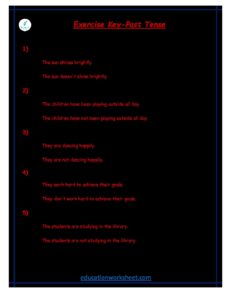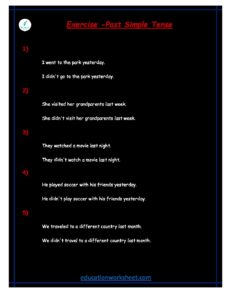changing Past Tense to negative and positive
changing Past Tense to negative and positive
Positive Past Tense:

Positive past tense is used to describe actions that have occurred in the past. These actions are usually completed and no longer happening. The formation of positive past tense depends on the regularity of the verb, with two primary categories: regular and irregular verbs.
- Regular Verbs: Regular verbs follow a predictable pattern when forming the positive past tense. The general rule is to add ‘-ed’ to the base form of the verb.
- Example 1: “She walked to the park yesterday.”
- Base form: walk
- Positive past tense: walked
- Example 2: “They played soccer last weekend.”
- Base form: play
- Positive past tense: played
- Example 1: “She walked to the park yesterday.”
- Irregular Verbs: Irregular verbs, on the other hand, do not follow a consistent pattern when forming the positive past tense. Each irregular verb has its own unique past tense form, which must be memorized.
- Example 1: “He went to the store.”
- Base form: go
- Positive past tense: went
- Example 2: “She ate pizza for dinner.”
- Base form: eat
- Positive past tense: ate
- Example 1: “He went to the store.”
Negative Past Tense:

Negative past tense is used to indicate that an action did not occur in the past. It is formed by combining the helping verb ‘did’ with the base form of the main verb, followed by ‘not’ (contracted as ‘n’t’).
- Regular Verbs: When transforming regular verbs into the negative past tense, you follow this pattern:
- Example 1: “She did not walk to the park yesterday.”
- Base form: walk
- Negative past tense: did not (didn’t) walk
- Example 2: “They did not play soccer last weekend.”
- Base form: play
- Negative past tense: did not (didn’t) play
- Example 1: “She did not walk to the park yesterday.”
- Irregular Verbs: Irregular verbs also use the helping verb ‘did’ to form the negative past tense. However, like in positive past tense, the irregular past tense forms must be used.
- Example 1: “He did not go to the store.”
- Base form: go
- Negative past tense: did not (didn’t) go
- Example 2: “She did not eat pizza for dinner.”
- Base form: eat
- Negative past tense: did not (didn’t) eat
- Example 1: “He did not go to the store.”
changing Past Tense to negative and positive

Additional Considerations:
- Questions in Past Tense: When asking questions in the past tense, the word order is reversed, with ‘did’ appearing at the beginning of the sentence. The base form of the main verb follows, and then the rest of the question.
- Example: “Did she walk to the park yesterday?”
- Negative Questions in Past Tense: Negative questions in the past tense are formed by placing ‘did not’ (didn’t) at the beginning of the sentence, followed by the base form of the main verb and the rest of the question.
- Example: “Didn’t they play soccer last weekend?”
Usage and Importance:
The ability to convert past tense verbs into both positive and negative forms is crucial for effective communication in English. It allows speakers and writers to convey whether an action happened or didn’t happen in the past, providing clarity and context to their statements.
Moreover, these forms are essential for storytelling, reporting events, discussing history, and describing past experiences. For instance, in literature, authors use various past tense forms to transport readers to different times and places, creating vivid and engaging narratives.
In summary, mastering the conversion of past tense verbs into positive and negative forms is an integral aspect of English grammar. It enhances our ability to communicate about past events accurately and effectively, whether in casual conversations, academic writing, or creative storytelling. Understanding the rules and nuances of past tense forms empowers individuals to express themselves fluently and coherently in English.
changing Past Tense to negative and positive Transforming Past Tense Verbs: Learn how to effortlessly convert past tense sentences into both negative and positive forms. Explore practical examples and master the art of grammatical versatility

